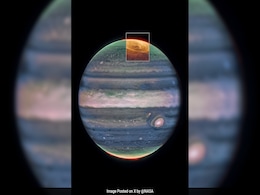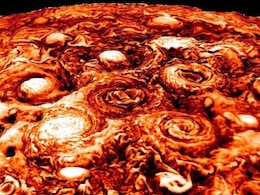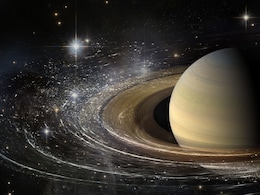New Jupiters
- All
- News
-

Scientists Stunned as Earth’s Magnetosphere Shows Reversed Electric Charge Patterns
- Sunday November 2, 2025
- Written by Gadgets 360 Staff
Scientists have discovered that Earth’s morning-side magnetosphere is negatively charged, overturning decades of assumptions about space electricity. Satellite data and simulations show the charge pattern flips near the equator but remains traditional at the poles. The breakthrough reshapes understanding of space weather and may also clarify elec...
-
 www.gadgets360.com
www.gadgets360.com
-

NASA’s JWST Produces First-Ever 3D Map of Distant Planet WASP-18b
- Monday November 3, 2025
- Written by Gadgets 360 Staff
NASA’s James Webb Space Telescope has created the first-ever 3D atmospheric map of an exoplanet, revealing the extreme conditions on WASP-18b, an “ultra-hot Jupiter” located 400 light-years away. Using infrared eclipse mapping, scientists discovered a scorching hotspot over 2,700 °C where water molecules are breaking apart. This groundbreaki...
-
 www.gadgets360.com
www.gadgets360.com
-

Researchers Discover New Plasma Wave in Jupiter’s Auroral Skies
- Monday August 25, 2025
- Written by Gadgets 360 Staff
Scientists at the University of Minnesota Twin Cities have detected a new plasma wave in Jupiter’s aurora using NASA’s Juno spacecraft. The finding, published in Physical Review Letters, reveals how Jupiter’s magnetic field shapes auroral activity differently from Earth. The study opens new directions for understanding planetary auroras and m...
-
 www.gadgets360.com
www.gadgets360.com
-

Unusual Plasma Waves Above Jupiter’s North Pole Can Possibly Be Explained
- Friday July 25, 2025
- Written by Gadgets 360 Staff
The presence of unusual plasma waves at Jupiter’s North Pole, detected by NASA’s Juno Spacecraft, has been explained by a group of scientists from the University of Minnesota. The team was led by Rober Lysak, wherein findings have resulted in the identification of the new types of plasma waves.
-
 www.gadgets360.com
www.gadgets360.com
-

Jupiter Was Once Twice as Big With 50x Stronger Magnetism, Says New Study
- Tuesday May 27, 2025
- Written by Gadgets 360 Staff
A 2025 study reveals Jupiter was once twice its current size with 50x stronger magnetism. Using moon orbits for data, researchers show how early Jupiter shaped the solar system’s structure.
-
 www.gadgets360.com
www.gadgets360.com
-

"100 Times Brighter": NASA's Webb Telescope Captures New Details Of Auroras On Jupiter
- Tuesday May 13, 2025
- Science | Edited by NDTV News Desk
NASA's James Webb Space Telescope (JWST) has captured stunning images of dancing lights, called auroras, on Jupiter. Similar to the Northern Lights we see on Earth.
-
 www.ndtv.com
www.ndtv.com
-

Juno Mission Sheds Light on Jupiter’s Storms and Volcanic Activity on Io
- Friday May 2, 2025
- Written by Gadgets 360 Staff
NASA’s Juno probe has uncovered colliding cyclones circling Jupiter’s north pole and flowing magma beneath the crust of its volcanic moon Io. Using thermal and microwave instruments, scientists have tracked atmospheric chaos and subsurface lava flows, offering new insights into the Jovian system’s extreme weather and volcanic activity. These ...
-
 www.gadgets360.com
www.gadgets360.com
-

New Study Reveals How Jupiter’s Storms Hide Ammonia
- Thursday May 1, 2025
- Written by Gadgets 360 Staff
A new study reveals Jupiter’s monster storms create mushballs—giant hailstones made of ammonia and water. This discovery explains the puzzling absence of ammonia in the planet’s upper atmosphere and suggests similar processes might be happening on gas giants across the universe.
-
 www.gadgets360.com
www.gadgets360.com
-

James Webb Telescope Captures Neptune’s Auroras in Stunning Detail
- Monday March 31, 2025
- Written by Gadgets 360 Staff
The James Webb Space Telescope has provided the first-ever direct images of Neptune’s auroras, revealing surprising details about the ice giant’s atmosphere. Unlike auroras on Earth, Jupiter, or Saturn, Neptune’s auroras appear across unexpected locations due to its tilted and offset magnetic field. Scientists also detected the presence of H...
-
 www.gadgets360.com
www.gadgets360.com
-

Saturn Becomes Undisputed 'Moon King' Of Solar System With Discovery Of 128 New Satellites
- Monday March 17, 2025
- Science | Edited by Abhinav Singh
With the new spottings, Saturn has usurped Jupiter which has 95 known moons, while Uranus (28) and Neptune (16) remain third and fourth on the list.
-
 www.ndtv.com
www.ndtv.com
-

Exoplanet WASP-121 b’s Atmosphere Features Iron Rains, Jet Streams, and More
- Thursday February 20, 2025
- Written by Gadgets 360 Staff
Astronomers have uncovered extreme weather patterns on WASP-121 b, a gas giant 900 light-years from Earth. The planet experiences iron rain, with metals vaporizing on its scorching dayside and condensing into liquid at night. Supersonic winds carry elements across its atmosphere, forming powerful jet streams. Using the Very Large Telescope, researc...
-
 www.gadgets360.com
www.gadgets360.com
-

Scientists Stunned as Earth’s Magnetosphere Shows Reversed Electric Charge Patterns
- Sunday November 2, 2025
- Written by Gadgets 360 Staff
Scientists have discovered that Earth’s morning-side magnetosphere is negatively charged, overturning decades of assumptions about space electricity. Satellite data and simulations show the charge pattern flips near the equator but remains traditional at the poles. The breakthrough reshapes understanding of space weather and may also clarify elec...
-
 www.gadgets360.com
www.gadgets360.com
-

NASA’s JWST Produces First-Ever 3D Map of Distant Planet WASP-18b
- Monday November 3, 2025
- Written by Gadgets 360 Staff
NASA’s James Webb Space Telescope has created the first-ever 3D atmospheric map of an exoplanet, revealing the extreme conditions on WASP-18b, an “ultra-hot Jupiter” located 400 light-years away. Using infrared eclipse mapping, scientists discovered a scorching hotspot over 2,700 °C where water molecules are breaking apart. This groundbreaki...
-
 www.gadgets360.com
www.gadgets360.com
-

Researchers Discover New Plasma Wave in Jupiter’s Auroral Skies
- Monday August 25, 2025
- Written by Gadgets 360 Staff
Scientists at the University of Minnesota Twin Cities have detected a new plasma wave in Jupiter’s aurora using NASA’s Juno spacecraft. The finding, published in Physical Review Letters, reveals how Jupiter’s magnetic field shapes auroral activity differently from Earth. The study opens new directions for understanding planetary auroras and m...
-
 www.gadgets360.com
www.gadgets360.com
-

Unusual Plasma Waves Above Jupiter’s North Pole Can Possibly Be Explained
- Friday July 25, 2025
- Written by Gadgets 360 Staff
The presence of unusual plasma waves at Jupiter’s North Pole, detected by NASA’s Juno Spacecraft, has been explained by a group of scientists from the University of Minnesota. The team was led by Rober Lysak, wherein findings have resulted in the identification of the new types of plasma waves.
-
 www.gadgets360.com
www.gadgets360.com
-

Jupiter Was Once Twice as Big With 50x Stronger Magnetism, Says New Study
- Tuesday May 27, 2025
- Written by Gadgets 360 Staff
A 2025 study reveals Jupiter was once twice its current size with 50x stronger magnetism. Using moon orbits for data, researchers show how early Jupiter shaped the solar system’s structure.
-
 www.gadgets360.com
www.gadgets360.com
-

"100 Times Brighter": NASA's Webb Telescope Captures New Details Of Auroras On Jupiter
- Tuesday May 13, 2025
- Science | Edited by NDTV News Desk
NASA's James Webb Space Telescope (JWST) has captured stunning images of dancing lights, called auroras, on Jupiter. Similar to the Northern Lights we see on Earth.
-
 www.ndtv.com
www.ndtv.com
-

Juno Mission Sheds Light on Jupiter’s Storms and Volcanic Activity on Io
- Friday May 2, 2025
- Written by Gadgets 360 Staff
NASA’s Juno probe has uncovered colliding cyclones circling Jupiter’s north pole and flowing magma beneath the crust of its volcanic moon Io. Using thermal and microwave instruments, scientists have tracked atmospheric chaos and subsurface lava flows, offering new insights into the Jovian system’s extreme weather and volcanic activity. These ...
-
 www.gadgets360.com
www.gadgets360.com
-

New Study Reveals How Jupiter’s Storms Hide Ammonia
- Thursday May 1, 2025
- Written by Gadgets 360 Staff
A new study reveals Jupiter’s monster storms create mushballs—giant hailstones made of ammonia and water. This discovery explains the puzzling absence of ammonia in the planet’s upper atmosphere and suggests similar processes might be happening on gas giants across the universe.
-
 www.gadgets360.com
www.gadgets360.com
-

James Webb Telescope Captures Neptune’s Auroras in Stunning Detail
- Monday March 31, 2025
- Written by Gadgets 360 Staff
The James Webb Space Telescope has provided the first-ever direct images of Neptune’s auroras, revealing surprising details about the ice giant’s atmosphere. Unlike auroras on Earth, Jupiter, or Saturn, Neptune’s auroras appear across unexpected locations due to its tilted and offset magnetic field. Scientists also detected the presence of H...
-
 www.gadgets360.com
www.gadgets360.com
-

Saturn Becomes Undisputed 'Moon King' Of Solar System With Discovery Of 128 New Satellites
- Monday March 17, 2025
- Science | Edited by Abhinav Singh
With the new spottings, Saturn has usurped Jupiter which has 95 known moons, while Uranus (28) and Neptune (16) remain third and fourth on the list.
-
 www.ndtv.com
www.ndtv.com
-

Exoplanet WASP-121 b’s Atmosphere Features Iron Rains, Jet Streams, and More
- Thursday February 20, 2025
- Written by Gadgets 360 Staff
Astronomers have uncovered extreme weather patterns on WASP-121 b, a gas giant 900 light-years from Earth. The planet experiences iron rain, with metals vaporizing on its scorching dayside and condensing into liquid at night. Supersonic winds carry elements across its atmosphere, forming powerful jet streams. Using the Very Large Telescope, researc...
-
 www.gadgets360.com
www.gadgets360.com
















